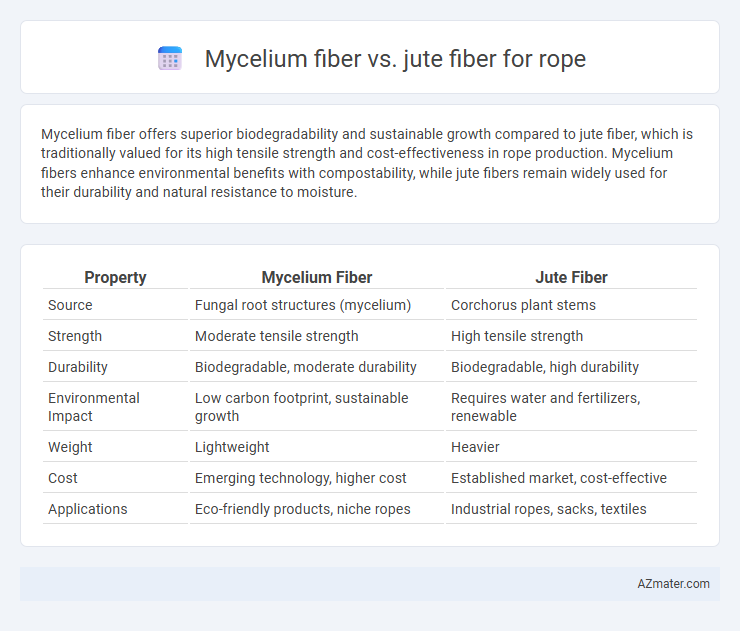Mycelium fiber offers superior biodegradability and sustainable growth compared to jute fiber, which is traditionally valued for its high tensile strength and cost-effectiveness in rope production. Mycelium fibers enhance environmental benefits with compostability, while jute fibers remain widely used for their durability and natural resistance to moisture.
Table of Comparison
| Property | Mycelium Fiber | Jute Fiber |
|---|---|---|
| Source | Fungal root structures (mycelium) | Corchorus plant stems |
| Strength | Moderate tensile strength | High tensile strength |
| Durability | Biodegradable, moderate durability | Biodegradable, high durability |
| Environmental Impact | Low carbon footprint, sustainable growth | Requires water and fertilizers, renewable |
| Weight | Lightweight | Heavier |
| Cost | Emerging technology, higher cost | Established market, cost-effective |
| Applications | Eco-friendly products, niche ropes | Industrial ropes, sacks, textiles |
Introduction to Natural Fibers: Mycelium vs Jute
Mycelium fiber, derived from the root structure of fungi, offers a lightweight, biodegradable alternative to traditional plant-based fibers like jute, known for its strength and durability in rope-making. Jute fibers, harvested from the Corchorus plant, provide high tensile strength and resistance to wear, making them ideal for heavy-duty ropes used in agriculture and marine applications. Both fibers emphasize sustainability, with mycelium showcasing rapid growth and eco-friendly processing, while jute maintains centuries-old cultivation practices supporting rural economies.
Origin and Sources of Mycelium and Jute Fibers
Mycelium fiber is derived from the root-like structures of fungi, primarily cultivated from species such as Ganoderma and Pleurotus, thriving on organic substrates like agricultural waste. Jute fiber originates from the bast of Corchorus plants, mainly Corchorus olitorius and Corchorus capsularis, predominantly grown in India and Bangladesh under warm, humid conditions. Both fibers are biodegradable, but mycelium fiber production leverages fungal mycelium growth on eco-friendly substrates, whereas jute fiber depends on traditional crop harvesting and retting processes.
Fiber Structure and Composition Comparison
Mycelium fiber consists of a network of chitin-rich fungal hyphae, providing natural flexibility and biodegradability, whereas jute fiber is composed mainly of cellulose, hemicellulose, and lignin, contributing to its strength and coarse texture. The hierarchical structure of mycelium fibers allows for lightweight and resilient rope construction, while jute's fibrous bundles offer high tensile strength but lower elasticity. Mycelium fibers feature a porous microstructure enhancing moisture absorption and biodegradability, contrasting with jute's more compact and rigid cell wall organization that lends durability but slower decomposition.
Strength and Durability: Mycelium vs Jute Ropes
Mycelium fiber ropes exhibit higher tensile strength and greater resistance to abrasion compared to traditional jute fiber ropes, making them more suitable for heavy-duty applications. The natural cellular structure of mycelium enhances durability by providing flexibility and resistance to environmental degradation such as moisture and UV exposure. Jute ropes, while biodegradable and cost-effective, tend to degrade faster under harsh conditions, resulting in reduced lifespan and strength over time.
Environmental Impact and Sustainability
Mycelium fiber, derived from fungal root structures, offers a highly renewable and biodegradable alternative to traditional jute fiber, which is sourced from the Corchorus plant and often associated with intensive agricultural practices. Mycelium cultivation requires minimal land, water, and chemical inputs, significantly reducing its carbon footprint and environmental degradation compared to jute farming. The rapid growth cycle and natural compostability of mycelium fibers contribute to sustainable rope production by minimizing waste and promoting circular economy principles over the longer cultivation and processing periods linked to jute fibers.
Biodegradability and End-of-Life Considerations
Mycelium fiber and jute fiber both offer excellent biodegradability, but mycelium fiber decomposes more rapidly due to its fungal origin, making it highly eco-friendly for short-term rope applications. Jute fiber, a natural plant fiber, degrades more slowly but provides sturdy durability ideal for long-lasting ropes while still breaking down naturally without releasing harmful residues. End-of-life, mycelium fiber ropes can be composted in weeks in controlled environments, whereas jute ropes often require several months to biodegrade under ambient conditions, influencing their respective sustainability profiles.
Manufacturing Processes and Scalability
Mycelium fiber production involves cultivating fungal mycelium on agricultural waste substrates, leading to a biodegradable, sustainable rope material; this process is energy-efficient but currently limited in industrial scale due to ongoing research and limited commercial facilities. Jute fiber extraction relies on retting and mechanical shaking of jute stalks, a well-established, high-yield process supporting mass production and global scalability with established supply chains. While jute fiber rope manufacturing benefits from decades of industrial refinement and cost-effectiveness, mycelium fiber rope offers innovative environmental benefits but requires further optimization for large-scale commercial viability.
Cost Analysis: Mycelium Rope vs Jute Rope
Mycelium fiber rope generally has higher production costs compared to jute rope due to the specialized cultivation and processing techniques required for fungal biomass. Jute rope benefits from well-established supply chains and large-scale farming, resulting in lower material and manufacturing expenses. However, mycelium rope's potential for biodegradability and sustainability may offset initial cost disparities in long-term applications.
Applications and Use Cases
Mycelium fiber offers exceptional biodegradability and flexibility, making it ideal for eco-friendly rope applications in agriculture, packaging, and marine industries where sustainability is critical. Jute fiber provides strong tensile strength and durability, widely used in traditional rope manufacturing for shipping, construction, and gardening due to its cost-effectiveness and resistance to environmental wear. Both fibers cater to different market needs with mycelium excelling in innovative, sustainable products while jute remains a staple for heavy-duty, economical rope solutions.
Future Prospects and Innovations in Fiber Technologies
Mycelium fiber offers groundbreaking potential in rope manufacturing due to its biodegradability, strength, and rapid renewability compared to traditional jute fiber. Innovations in mycelium processing, such as bio-composite enhancements and fungal strain engineering, are accelerating its commercial viability and sustainability profile. Future prospects prioritize scalable eco-friendly production methods, positioning mycelium fiber as a superior alternative to jute in eco-conscious rope applications.

Infographic: Mycelium fiber vs Jute fiber for Rope
 azmater.com
azmater.com